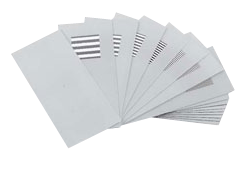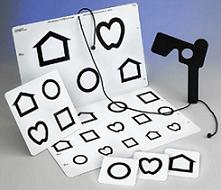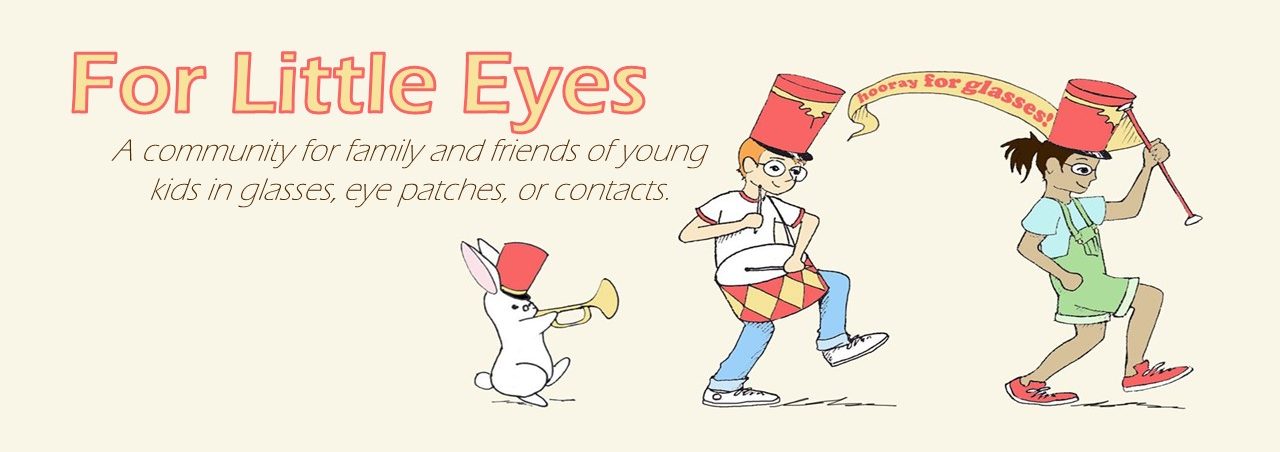
Teller Acuity Cards, picture from http://www.stereooptical.com
Zoe is young enough that most of her eye exams didn’t use any of the eye charts that we normally think of to determine her prescription. They used Teller Acuity Cards – where they showed Zoe a grey card with a box of black and white stripes, if she looks at the box, then she can see the stripes. They show cards with progressively thinner stripes until she no longer noticed them (they get thin enough that I could hardly perceive the box of stripes). You can read more about the test in this information sheet from Seattle Children’s Hospital (pdf). They also dilate her eyes and then the ophthalmologist use a retinoscope to measure the refractive error of her eyes.
At her last appointment in December, she’d just turned 2, they tried having her use an eye chart. Zoe was given a card with the 4 different shapes, and then the optician would point to a shape and ask Zoe to point to the matching shape on her card. Zoe didn’t get it. She was deep in the mimicry stage and did a very good impression of the optician, holding her card out for her to see and pointing at each shape one by one. Cute, but ultimately unhelpful.

Lea chart. From the Visionary Eyecare Blog
We tried again at her appointment on Friday and she did awesome – both in terms of understanding what we were asking her to do, and in that she’s seeing well and equally well out of both eyes. About a month ago, her daycare had focused on shapes, and just recently, we’d started playing matching games with her. Though we weren’t intentionally trying to prepare her for the eye exam, I think those activities helped a lot in getting her to understand the task.
If you have a young toddler going in for their first eye exam, or if your child is getting old enough to start using eye charts, I’d recommend practicing ahead of time, especially with matching games. We played a memory game – where you have cards with pictures on them laid out and you turn them over and try to find a match – but we had all the cards face up. I’d pick up a card and ask Zoe to find a match. You could draw a bunch of different shapes on paper and again ask your child to find matches. Shape-sorters would probably also work as well. At home, you can explain that these are matching games, and then at the eye exam, again explain that you’re going to play another matching game. Zoe seemed to find the exam pretty fun.
The Visionary Eyecare’s Blog has a great post with pictures of some of the more common eye charts for children, if you want to look at some examples. At Zoe’s appointment, they used the Lea chart.
To cover Zoe’s eyes, the optician hung a patch over her glasses on one eye, and then the other. She told Zoe that Zoe would be a little pirate for a bit. I don’t know if it’s related or not – but I can’t come up with another explanation – that evening, Zoe kept singing to herself, “hi-yo, hi-yo, I’m a pirate. Pirate, pirate, I’m a pirate.”

Wow…great blog post!!
I’m so happy that you were able to use my blog post about Children’s Eye Charts! Its actually one of the most poular posts on my blog – apparently there are a lot of parents looking for this information but, just can’t find it.
Kudos to you for educating parents about Children’s eye care!
LikeLike
I have to brag on Sam. When he went for his check up a few months ago, he was sitting in my lap in the exam chair while the nurse was asking all of the routine questions. Sam was looking around and spied the letters being projected for the letter eye chart and proceeded to read it out loud.
The nurse took him through the entire letter chart and he didn’t miss a single letter. She was so impressed she went and told one of the other nurses.
She said she’d never had a three year old to be able to read the letter chart before. So, practicing those ABCs has unintended benefits, too.
LikeLike
Way to go Sam! Definitely a good reason to practice the ABCs
LikeLike
That’s awesome she was successful with “the matching game”. Both my kids like the eye doctor and the “games” they get to play! I like that!!! The one we go to uses the chart with the big hand at the top and other pictures are a birthday cake, chicks, man on a horse, etc. The last time Belle even tried using one with letters like a “big girl”! They grow up so fast!!!!
LikeLike
Mia had an eye evaluation on Friday, they used the Teller acuity cards. Her visual acuity in her right eye (without a corrective lens) is 20/1300. I am so upset, she was 20/980 about 1-2 months ago. Either the test was inaccurate or her vision has declined. Her visual acuity with a corrective lens (+7) is 20/380. Her prescription was +2.75 which has increased to +7. I think this is due to the amount of time we have wasted waiting for her contact lens, which she still has not received. We have to wait until June 3rd. I feel like I am completely taking away her vision every time I place her occluding lens in her eye. Can you imagine having vision of 20/1300 and trying to function for 5 hours everyday. I can’t believe she doesn’t have stitches yet. I don’t understand why this is not considered “urgent“. They consider 20/200 legally blind, Mia’s vision is 6 times worse and she has to try to function. Sorry, this is just really bad news, I thought we were making progress.
LikeLike
Oh Danielle, how upsetting and frustrating! I have read that the Teller cards can have pretty variable results, especially if different people are giving the test. I hope that contact lens does help, it seems like it must. Like you said, when you’re patching, she has nearly no vision.
LikeLike
Thanks for sharing. This is really very useful especially for us moms who are worried on how our kids would undergo when eye check up arrives. It would also be of great help to visit sites like this. Just like this one
Thanks again and keep up the good work! Hi to Sam!
LikeLike
Our doctor doesn’t seem to have really all the activities mentioned above. He has more of a picture chart where it projects images & Aubrie has to name the image and they get progressively smaller. Sometimes I think the images are tough though! A rotary phone she never gets right! It seems to work really well as a substitute eye chart. They also have 3D images to check her eyes to make sure she can see those in 3D. I can’t wait for the day she can read an eye chart…I think it will take a lot of the stress off of me worrying that she’s getting the right prescription. I never know if it’s an image she just doesn’t get or if it’s truly her eyes.
LikeLike
Our PO uses the Allen Picture Cards, but has also recenty used the letter chart since Elly knows her letters. I asked what the difference is and it sounds like there is more statistics and studies done for the alphabet chart so it is more reliable? I know that on either test, when she doesn’t see something she gets as close to the edge of the chair and leans forward. If she still can’t see, she just makes up some random thing. It is very hard to see her want to know what it is, but unable to see the 2nd line. I wonder what the accuracy rate is with kids as we have decreased some visits as well.
LikeLike
I am with you on the accuracy rate of these tests, amomofelly! I don’t believe that either tests are completely accurate when it comes to children because our children want to please us so much, they can become very good at guessing. They can even remember when it goes from testing the good eye to testing the bad eye, so I always have the PO test the bad eye first. I know that Ellie guesses or just completely shuts off looking at the pictures when she cannot see or make it out.
LikeLike
I imagine that the letters are more reliable, if only because more studies have been done to develop reliable vision tests. Then again, when I was in high school, I had a horrible time getting contacts that fit right, and so was in the optometrist’s office a lot. I memorized the 20/20 line (if memory serves, it was “T Z V E C L”) – it was very hard for me to give honest answers, because if you know what the letters are supposed to be, it’s easy to make them out.
Our optician pointed to the shapes in random order on each line, quite possibly to limit the amount of memorizing. Having them test the weak eye first seems like a great idea. Zoe would indicate that she couldn’t see a shape by shaking her head and shrugging, but I imagine she’ll start guessing soon.
LikeLike
I totally agree…I think our kids get very good at guessing or compensating when it comes to their vision. When Aubrie got glasses at 20 months she was starting to cross her eyes & was prescriped +5.5 in both eyes. At the same time she was putting 9 piece puzzles together upside down. It just blew my mind on how well she was compensating for her poor vision even to trick us into thinking she could see! When her pediatrician said she’ll probably need glasses I just couldn’t understand! I don’t know how many arguments I got into with some family members thinking she could see well b/c of some things she was still able to do. Now they realize that yes she truly needed those glasses. I guess for our children their vision is all they know up until that point & it’s amazing what they can do in order to get by.
LikeLike
Our PO used projected images on a screen for the acuity testing. (basic shapes, objects…duck, hand, tree..etc). N is typically very stubborn and won’t cooperate with either the images or letters…though upon our last visit he relented (I think he’s finally getting comfortable with our PO as part of the routine..) and ‘read’ the images.
We, perhaps moreso the PO, were thrilled. We’re at 20/50 in both, corrected. At -7.5 R and -18 L the PO was very pleased at the acuity attained with the new lens.
LikeLike
What great news that N is doing so well with the new lens, George. I know you were concerned about the jump in prescription, but it sounds like it’s serving him well.
LikeLike
George, do you have anything on here about N’s story? I would be interested in reading it, and you seem so knowledgeable about all of this! From your post “I think he’s finally getting comfortable with our PO as part of the routine..” is N affected by autism? I am fascinated by autism… (is it bad to be fascinated by it?)
LikeLike
Nicole, I’ll let George answer your specific questions, but he did write up N’s story here http://littlefoureyes.com/2008/09/17/your-stories-a-little-boy-in-glasses/
LikeLike
Nicole,
nope, not autism…just grumpy-ism. 🙂
LikeLike
haha! Don’t we all have that?
LikeLike
Another thing to consider is the fact that the eye can be susceptible to certain diseases, just like any other part of the body. Most people have heard of the most common diseases of the eye, which include glaucoma and diabetic retinopathy. Since these diseases usually exhibit no symptoms in their early stages, it is crucial that you uphold a proactive strategy to prevent them. This can only be done by paying a scheduled visit to have your eye exam. The eye doctor will be able to check for diseases like glaucoma so that you can take the appropriate steps to eliminating the disease before it gets any worse. Though these diseases are more commonly found in older people, it is important to note that there is still a chance for eye disease to develop at an earlier age.
LikeLike